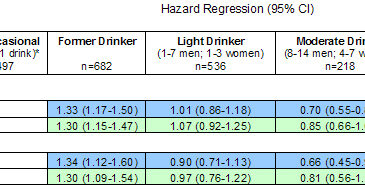The harmful effects of heavy alcohol drinking are well documented (e.g., World Health Organization, 2004). Recent research, however, suggests that there are potential health benefits associated with moderate alcohol intake (e.g., physical functionality, reduced disability and mortality: Cawthon et al., 2007; Karlamangla et al., 2009; Lang, Guralnik, Wallace, & Melzer, 2007). However, these studies have not fully controlled for variables that might account for the apparent relationship between alcohol and health. This week, the DRAM reviews a longitudinal study that explores the possibility of a causal relationship between alcohol intake and physical mobility among older adults, controlling for multiple lifestyle factors (Maraldi et al., 2009).
Methods
- The current study included 3,061 participants enrolled in the Health Aging and Body Composition (Health ABC) study.
- Participants were well-functioning adults, aged 70-79 at intake, recruited from the metropolitan areas of Pittsburgh, PA and Memphis, TN
- Self-reported measures included:
- At baseline, alcohol intake (i.e., number of drinks consumed in a typical week during the previous 12 months), as well as demographic, lifestyle, health, and cognitive variables.
- Mobility assessments every 6 months for 78 months coded as: No limitation; Mobility limitation (two consecutive reports of difficulty walking ¼ of a mile or climbing stairs without rest); or Mobility disability (two consecutive reports of severe difficulty or inability to walk ¼ mile or climb stairs).
- Researchers performed Cox proportional hazard regression analyses (a form of survival analysis) on the data to determine the relationship between alcohol intake at baseline and mobility status while controlling for the baseline variables.
Results
- The Figure shows the results of two models.
- Model 1 predicted mobility status from baseline alcohol intake, controlling for demographics (i.e., age, sex, race and site location).
- Model 2 replicated Model 1, but also controlled for lifestyle characteristics (i.e., education, family income, smoking status, physical activity and body mass index).
- In Model 1, moderate alcohol intake was associated with a lower risk of mobility limitation and mobility disability compared to never or occasional alcohol intake, as shown in blue in the Figure.
- As the green section of the Figure shows, however, Model 2 found that moderate alcohol intake was no longer significantly associated with a lower risk of mobility limitation or mobility disability compared to never or occasional alcohol intake.

Figure. Risk of mobility problems according to alcohol intake. *Number of drinks in a typical week during the 12 months previous to baseline. Note: Two participants are excluded from this analysis because they did not have follow-up data. Follow-up was from baseline to the time of the first of two consecutive reports of mobility measures. For participants who died and did not experience mobility disability prior to death, data were censored at time of death. Click image to enlarge.
Limitations
- This study used self-report for the alcohol intake variables.
- Researchers assessed alcohol intake only once at the beginning of the study. Changes in alcohol intake over the study period could have affected the results.
- Researchers controlled for physical activity in Model 2 of the analysis. This control variable is so similar to the mobility measure that controlling for it might distort the results of the analysis.
- The age range and geographic locations might reduce the generalizability of the results.
Discussion
This study indicates that, among a cohort of well-functioning older adults, moderate and light alcohol intake was associated with a lower rate of reduced mobility. However, a causal relationship between alcohol intake and physical functionality could not be determined. After adjusting the results for lifestyle characteristics, the association between alcohol use and mobility was largely diminished. These results suggest that lifestyle choices, rather than alcohol intake, might be more important influences on physical functionality among older adults.
— Tasha Chandler
What do you think? Please use the comment link below to provide feedback on this article.
References
Cawthon, P. M., Fink, H. A., Barrett-Connor, E., Cauley, J. A., Dam, T. T., Lewis, C. E., et al. (2007). Alcohol use, physical performance, and functional limitations in older men. Journal of the American Geriatrics Society, 55(2), 212-220.
Maraldi, C., Harris, T. B., Newman, A. B., Kritchevsky, S. B., Pahor, M., Koster, A., et al. (2009). Moderate alcohol intake and risk of functional decline: The health, aging, and body composition study. Journal of the American Geriatrics Society, 57(10), 1767-1775.
World Health Organization. (2004). Global status report on alcohol 2004: World Health Organization.
Cawthon, P. M., Fink, H. A., Barrett-Connor, E., Cauley, J. A., Dam, T. T., Lewis, C. E., et al. (2007). Alcohol use, physical performance, and functional limitations in older men. Journal of the American Geriatrics Society, 55(2), 212-220.
Karlamangla, A. S., Sarkisian, C. A., Kado, D. M., Dedes, H., Liao, D. H., Kim, S., et al. (2009). Light to moderate alcohol consumption and disability: Variable benefits by health status. American Journal of Epidemiology, 169(1), 96-104.
Lang, I., Guralnik, J., Wallace, R. B., & Melzer, D. (2007). What level of alcohol consumption is hazardous for older people? Functioning and mortality in U.S. and English national cohorts. Journal of the American Geriatrics Society, 55(1), 49-57.




